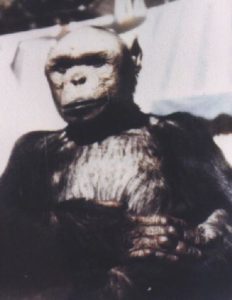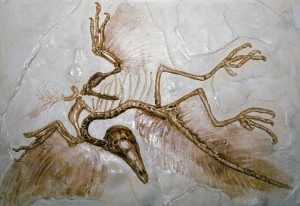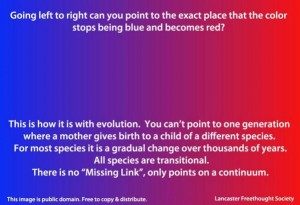 There’s a lot of confusion these days regarding the concept of evolution. In general terms it’s a fairly simple process, but the details can be a little harder to grasp. There are elements of the concept that are almost infamous for their wide misrepresentation by certain segments of society. One of those is the idea of a transitional species.
There’s a lot of confusion these days regarding the concept of evolution. In general terms it’s a fairly simple process, but the details can be a little harder to grasp. There are elements of the concept that are almost infamous for their wide misrepresentation by certain segments of society. One of those is the idea of a transitional species.
That terms refers to individual species that represent the evolutionary path from an older one to a newer one. The confusion about this idea is embodied by the infamous missing link argument. That argument originates with ancient Greece and the great chain of life concept, which extended into modern Neoplatonism. Later adopted by the deist school of thought regarding the origins of life, it details a hierarchical structure to all life as decreed by God. The progression is given as starting with God and proceeding down through angels, demons (fallen/renegade angels), stars, moon, kings, princes, nobles, men, wild animals, domesticated animals, trees, other plants, precious stones, precious metals, and other minerals. The missing link is therefore any species we would expect to see bridging any gap between any one of those categories, but which is not represented in the record.
This mindset, though pagan in origin, has dominated religious thought for centuries, and with the monumental breakthrough that was Charles Darwin’s On the Origin of Species, the primacy of the idea began to break up. The missing link idea is now one of the most oft-leveled arguments against the validity of the Theory of Evolution.
Popular culture has exploited this confusion for its own purposes many times. Virtually every monstrosity that has graced the silver screen has been an example of the missing link in one form or another (at least those monsters that originated on Earth). King Kong, the Planet of the Apes, even Paramount Pictures’ Monsters vs. Aliens with their namesake character, the Missing Link, have cashed in on the idea for much gain. And who could leave Bigfoot or Sasquatch out of this discussion? The popularity of the missing link idea seems to have accelerated a general misunderstanding of the process of evolution and there have been a few real life examples of creatures that were thought to be missing links in our evolutionary past.

Archaeopteryx fossil
Archaeopteryx, Australopithecus afarensis, and the tiktaalik are famous examples of purported missing links in the fossil record. In each case it’s been argued that the fossil showed transitional characteristics between a parent species and a child species, though each has been debunked, so to speak.
A lesser known and far more recent example of a purported transitional species, personified in a living creature, was Oliver the Humanzee. As his name might suggest, Oliver was a chimpanzee. He was found and taken from the Democratic Republic of the Congo in 1960 by primate trainers Frank and Janet Berger. The Berger’s became interested in Oliver, then approximately two years old, because his behaviour and appearance suggested to them that he was a different species of primate than his peers, one much closer to humans. Oliver’s face was flatter than other chimpanzees and has human-looking characteristics, and he almost exclusively walked upright. It was said that he preferred the company of humans over other primates and mimicked human behaviour whenever possible.
 Oliver lived with the Berger’s for the next 16 years, when in 1977 he was handed over to a small theme park in Buena Park, California. It seems that Oliver had taken a romantic interest in Mrs. Berger and had become a danger to her after several attempts to mate with her. The next 21 years of his life had Oliver being showcased as an oddity of the natural world and used as a test subject for scientific and cosmetic research, until he was retired, so to speak, with the primate sanctuary Primarily Primates in Texas in 1998. At that point he was largely blind and terribly arthritic, but conservationists and rehabilitators provided him with a comfortable existence until his death in 2012.
Oliver lived with the Berger’s for the next 16 years, when in 1977 he was handed over to a small theme park in Buena Park, California. It seems that Oliver had taken a romantic interest in Mrs. Berger and had become a danger to her after several attempts to mate with her. The next 21 years of his life had Oliver being showcased as an oddity of the natural world and used as a test subject for scientific and cosmetic research, until he was retired, so to speak, with the primate sanctuary Primarily Primates in Texas in 1998. At that point he was largely blind and terribly arthritic, but conservationists and rehabilitators provided him with a comfortable existence until his death in 2012.
As mentioned, Oliver was, for a period of more than 20 years, considered to be a living example of a transitional species or missing link between apes and humans. Many people speculated that he was the first in a line of primates to evolve beyond being a mere animal and could have been the progenitor of an entirely new species of proto-human.
 There are many problems with this idea though, not the least of which is the fact that all species are transitional, so the term is functionally meaningless. When you look at the fossil record for any particular species, it is impossible to determine where along that spectrum of evolution a parent species stopped being what they were and began being what the child species ended up being. The child of a chimpanzee is always going to be a chimpanzee, except when you look at several hundred or thousand generations. Then you can see a slow progression from the parent species to the child species, but no one example from the progression can be singled out as a distinct species among its neighbours in the line.
There are many problems with this idea though, not the least of which is the fact that all species are transitional, so the term is functionally meaningless. When you look at the fossil record for any particular species, it is impossible to determine where along that spectrum of evolution a parent species stopped being what they were and began being what the child species ended up being. The child of a chimpanzee is always going to be a chimpanzee, except when you look at several hundred or thousand generations. Then you can see a slow progression from the parent species to the child species, but no one example from the progression can be singled out as a distinct species among its neighbours in the line.
Another problem is that, even if Oliver represented a new species of chimpanzee, what his genetic line would ultimately evolve into would not necessarily or even conceivably be anything like a human, beyond superficial similarities. After all, we do share a common ancestry with all primates, but we could no more spawn a new type of monkey than could a baboon spawn a lemur. It just doesn’t work that way.
 The argument was settled in 1996 by a geneticist from the University of Chicago, who revealed that Oliver had 48 chromosomes, not 46 like humans, which is consistent with all other chimpanzees. Further study revealed that his facial features were in line with the standard range of variability shown in the Common Chimpanzee, and that his behaviour and habit of walking upright was an aberration brought about because of his exposure to such behaviour in his early life and his lack of chimpanzee companionship throughout his life.
The argument was settled in 1996 by a geneticist from the University of Chicago, who revealed that Oliver had 48 chromosomes, not 46 like humans, which is consistent with all other chimpanzees. Further study revealed that his facial features were in line with the standard range of variability shown in the Common Chimpanzee, and that his behaviour and habit of walking upright was an aberration brought about because of his exposure to such behaviour in his early life and his lack of chimpanzee companionship throughout his life.
One of the most disturbing things about Oliver’s story, is the fact that from 1989 when he was acquired by the Buckshire Corporation – who were responsible for some of the worst mistreatment and inhumane living conditions for animal testing – until his true taxonomy was determined in 1996, it was a widely held belief that he represented a new and distinct evolutionary jump from a wild animal to a more civilized proto-human, yet he was still treated as a side show fixture and a commodity to be exploited. It would be nice to think that humanity has progressed since that point, and that we would treat our companions on this planet with more respect than that, but such ideological thinking is not supported by reality.
Oliver’s story is a sad one, he was singled out for being different and held captive for his entire life. He suffered horrible tortures at the hands of scientists (as much as a person researching new eye make-up formulations can be called a scientist) and ultimately died never knowing what it meant to be a chimpanzee. His fate is not unique among his kind, but that makes it no less tragic. He was not a missing link in our evolutionary history, nor his own. He was the product of a biological system that is known for producing oddities and aberrations, but one which we humans seem to have only a rudimentary understanding of thus far. Our pursuit of knowledge should never come at the expense of another living creature.
